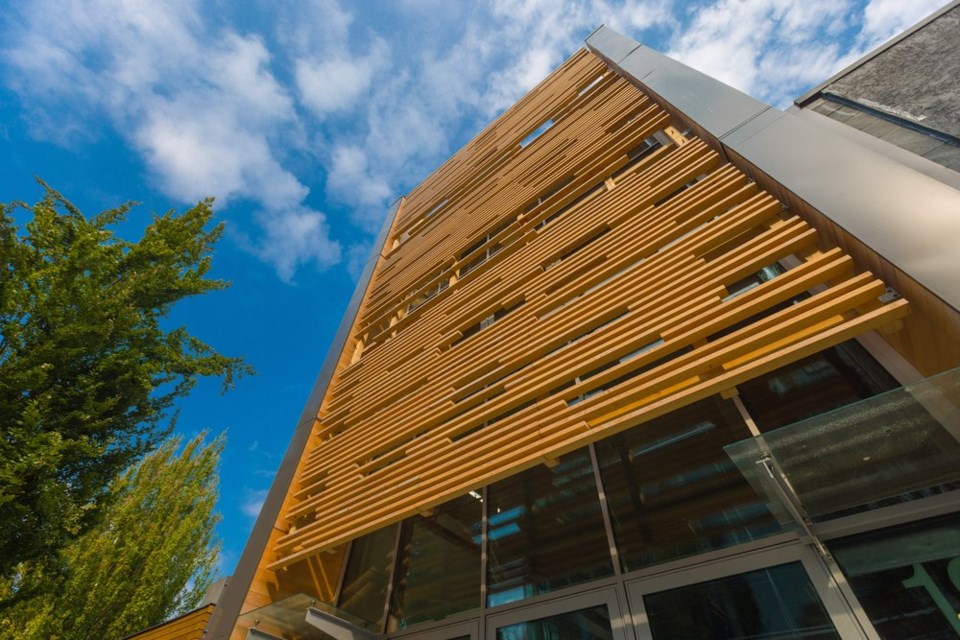Driven by government initiatives and rising industry interest, B.C.’s country-leading mass-timber industry is poised for a new chapter of development.
New incentives from the City of Vancouver and the provincial government are expected to drive the development of more mass-timber buildings, according to those who spoke to BIV.
At the same time, there is growing interest within the private development community to take on mass-timber projects, said Robert Malczyk, principal at Timber Engineering Inc.
“I think we passed the point of time where it was only pilot projects. Now we see the wave of private projects and owners are seeing that it really makes sense to build mass timber,” said Malczyk.
Sarah Bingham, vice-president of development and sustainability with Adera Development Corp., said that there are more projects “seriously contemplating and putting in applications using mass timber.”
While there is no doubt that there is growing interest in mass timber, Grant Newfield said that the mass timber market still has a way to go.
“You have to make the way for change, you have to write the codes to adopt change and then there is always a lag between getting the industry up to speed, as the demand increases,” said Newfield, a professional engineer and principal at Read Jones Christoffersen Ltd., also known as RJC Engineers.
“We’re in that stage of an evolving [industry], but it’s still going to be a five-year period to see it get to a more mature level.”
B.C. leads the country in mass-timber construction, with 355 such projects completed, under construction or planned from 2007 through to the first three months of 2024, according to a federal government map that tracks mass-timber projects. Quebec has the second-highest number of such projects, at 221.
B.C.’s total represents 42.6 per cent of the 832 mass-timber projects in various stages of planning or development across Canada.
Within B.C. there are 26 projects under construction and 39 planned.
“The first projects were definitely public projects,” said Malczyk. “But now, more and more, it’s the private projects.”
There are currently 27 projects under the category of “private” ownership that are planned or under construction in the province. This is in addition to 26 public, four non-governmental and eight Indigenous projects that are planned or under construction.
“Mass timber creates healthier, better-quality structures in comparison to other building materials. It’s a renewable resource with a cleaner carbon footprint. It matches the strength and durability of concrete and steel with a fraction of the weight and the ability to pre-fabricate mass timber creates efficiency in the installation process with fewer greenhouse gas emissions,” said Bingham.
Adera has two mass-timber projects completed in Surrey and West Coquitlam with another four in the planning stages in North Vancouver and Coquitlam. The development company has even created its own mass timber product called SmartWood.
The province announced last December it would consider changes to B.C. building and fire codes to allow as many as 18 storeys for mass timber residential and office buildings, instead of the current 12-storey limit.
The changes will also allow for more exposed mass timber and will allow for more mass timber building types, such as schools, shopping centres and industrial facilities.
In addition, Vancouver city council voted in February to amend the city’s zoning and development bylaw, proposing a rezoning policy to accelerate mass timber construction for new buildings taller than six storeys.
New buildings in areas that would typically allow for eight to 11 storeys can qualify for two additional storeys, and buildings in areas that allow for 12 or more storeys can qualify for three additional storeys.
Vancouver will also be hosting the global mass-timber conference—Woodrise International Congress—in 2025.
“It’s just a tidal wave of interest in mass timber, corporate offices, other types of buildings, and the issue is now with supply,” said Malczyk.
The two main roadblocks that developers face when building with mass timber are accessing supply, and navigating a shortage of skilled workers in the province’s construction industry.
Penticton-based Structurlam filing for bankruptcy and being acquired by Mercer Mass Timber has had a negative impact on supply, said Newfield.
This is further compounded by big projects such as Walmart, Inc.’s international headquarters in Arkansas which set to use 1.7 million cubic feet of mass timber.
“There is so much demand right now,” said Malczyk. “They simply need to finish these huge projects and we need capacity for medium and smaller-sized projects.”
Bingham said Adera has learned to involve manufacturers “early to get the design underway using consultants early and to coordinate early.”
“With this additional push towards incentivizing mass timber, we also need to look the manufacturing side, including plants and skilled labor and find ways to create that additional capacity,” she said.
“Just like any building material, you do need to have some experience or understanding of how to use it, but that comes with more projects using the material.”




